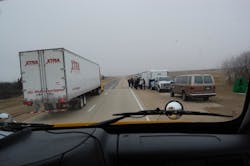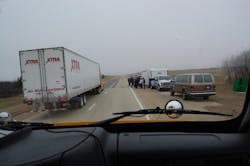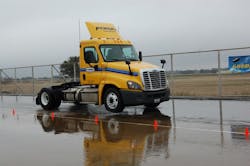It’s all about the extremes at the proving grounds
Talk about an experience in contrasts.
The last time I visited Goodyear Tire & Rubber Co.’s San Angelo Proving Grounds (SAPG) nearly nine years ago, the temperatures hovered around 125 degrees Fahrenheit in the (extremely sparse) shade.This go around, however, temperatures stayed in the frigid 30s, combined with sleet driven by an at-times 40 mph wind.
Great stuff for testing the mettle of truck tires, but not so much for the humans chronicling those tests.
[I also got to meet up with Charles Ruff again, just like back in 2006. A 19-year SAPG veteran, he said he hopes the third time I come back to visit will be the charm, as in an occasion when the weather in San Angelo won’t be so extreme.]
Yet in both cases the reason for visiting Goodyear’s SAPG facility – the largest of six proving grounds it operates around the world – remains the same: how to build tires that help deliver better fuel economy for commercial vehicles without sacrificing longevity, traction, and other key performance metrics.
Nearly a decade ago, Goodyear used its SAPG location as a backdrop for the unveiling of its then all-new Fuel Max line of truck and trailer tires. This year the company returned to the same spot to put some of the latest additions to the Fuel Max line through their paces.
Built back in 1944, SAPG tests about 23,000 different Goodyear passenger vehicle and truck tire models annually and represents in the words of Chris Queen, the facility’s manager, the “last stop” in the tire development process.“Our tests cover all spectrums of tire characteristics: rolling resistance, wet and dry traction and handling, tread wear, etc.,” he explained. “Our product is data and we generate a lot of it.”
[You can view more photos of truck tire tests at the SAPG facility by clicking here and here.]
So remote is the SAPG that the facility’s staff created not one but two volunteer from brigades from its ranks – engineers, mechanics, construction workers and others who pull double-duty, undergoing continual fire and rescue training that’s equal to what the local fire department personnel undergo.
“The response time of our brigades is about 4 minutes and when you compare that to the at least 20 minutes it would take an ambulance to get out to us, you see why having our own [fire & rescue] teams on site is so important,” Queen explained.
It sure shows why testing tires to ensure they hold up to the rigors of the trucking world is neither easy nor simple work.


